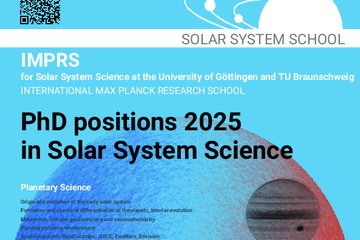All genres
161.
Talk
Dynamics and thermal structure in the quiet Sun seen by SPICE. AGU Fall Meeting, Online (2020)
162.
Talk
Relative coronal abundance diagnostics with Solar Orbiter/SPICE. AGU Fall Meeting, Online (2020)
163.
Talk
Coronal loop footpoints threaded with small-scale mixed polarity surface magnetic fields. SOLARNET IV: The Physics of the Sun from the Interior to the Outer Atmosphere, Lanzarote, Spain (2017)
164.
Talk
Rotational motion in transition region loops. 8th Coronal Loops Workshop: many facets of magnetically closed corona, Palermo, Italy (2017)
165.
Talk
Signs of helical transition region loops embedded in filament channels. Rocks \& Stars II, Göttingen, Germany (2017)
166.
Talk
Chromospheric response to prolonged small-scale reconnections. IRIS-6: The Chromosphere, Stockholm, Sweden (2016)
167.
Talk
Using coronal seismology to estimate the magnetic field strength in a realistic coronal model. 2nd International Sino-German Symposium of Solar Physics: Multi Waveband Observations and Modeling of Solar Activity, Bad Honnef, Germany (2015)
168.
Talk
A closer look at the footpoints of coronal loops rooted in a sunspot umbra. Hinode 9 Science Meeting, Belfast, Ireland (2015)
169.
Talk
Magnetic Field Lines and Coronal Loops A Difficult Relation. Living With a Star / Iris / Hinode Meeting, Portland, USA (2014)
170.
Talk
Magnetic field lines and coronal loops. 14th European Solar Physics Meeting, Dublin, Ireland (2014)
171.
Talk
Magnetic field lines in 3D MHD models of the solar corona. Max-Planck/Princeton Center for Plasma Physics, General Meeting, Berlin, Germany (2014)
172.
Poster
First results from the EUI and SPICE observations of Alpha Leo near Solar Orbiter first perihelion. AGU Fall Meeting, Online (2020)
173.
Poster
First results from combined EUI and SPICE observations of Lyman lines of Hydrogen and He II. AGU Fall Meeting, Online (2020)
174.
Poster
Calibrating optical distortions in the Solar Orbiter SPICE spectrograph. AGU Fall Meeting, Online (2020)
175.
Poster
Signs of helical transition region loops embedded in filament channels. European Solar Physics Meeting, Budapest, Hungary (2017)
176.
Poster
The SPICE Spectral Imager on Solar Orbiter: Linking the Sun to the Heliosphere. COSPAR-41, Istanbul, Turkey (2016)
177.
Poster
Solar abundances with the SPICE spectral imager on Solar Orbite. COSPAR-41, Istanbul, Turkey (2016)
178.
Poster
Using coronal seismology to estimate the magnetic field strength in a realistic coronal model. Hinode 9 Science Meeting, Belfast, Ireland (2015)
179.
Thesis - PhD
Mehrflüssigkeitsmodelle der unteren Sonnenatmosphäre und Schlußfolgerungen für den Sonnenwind. Dissertation, Georg-August-Universität Göttingen (1997)











